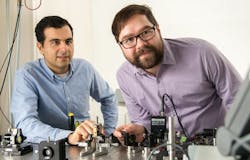Stanford modifies OPO technology to improve ultrashort pulse bandwidth and speed
Researchers from the Ginzton Lab at Stanford University (Stanford, CA) have modified optical parametric oscillators (OPOs) to expand the limited wavelength ranges of light that they are able to produce. Following a counterintuitive decision, the researchers may have found a solution to this weakness that could lead to smaller, lower-cost, and more efficient sources of light pulses.
RELATED ARTICLE: Fiber-laser in-band pumping enables novel 2 micron higher-power short-pulse laser
Their work, published in Physical Review Letters, demonstrates a new way to produce femtosecond pulses in desirable wavelength ranges using a temporal simulton method. The technology could potentially lead to better detection of pollutants and diseases by merely scanning the air or someone’s breath.
In OPOs, pulses of light from a traditional laser are passed through a special crystal and converted into a wavelength range that's difficult to access with conventional lasers. Then, a series of mirrors bounce the light pulses around in a feedback loop. When this feedback loop is synchronized to the incoming laser pulses, the newly converted pulses combine to form an increasingly strong output.
Traditionally, people could not convert much of the initial light pulses into the desired output with such a contraption. But to be effective in real-world applications, the group had to bump up that percentage. "We needed higher conversion efficiency to prove it was a source worth studying," said Alireza Marandi, a staff member in the Ginzton Lab. "So we just said, 'OK, what are the knobs we have in the lab?' We turned one that made the mirrors reflect less light, which was against the standard guidelines, and the conversion efficiency doubled." The researchers published their initial experimental results two years ago in Optica.
Cranking up the power in a conventional design usually results in two undesirable outcomes: The pulses lengthen and the conversion efficiency drops. But in the new design, where the researchers significantly decreased the reflectivity of their mirrors, the opposite occurred. After more simulations and lab experiments, the group found that the key was not just making the mirrors less reflective but also lengthening the feedback loop. This lengthened the time it took for the light pulses to complete their loop and should have slowed them too much. But the lower reflectivity, combined with the time delay, caused the pulses to interact in unexpected ways, which pulled them back into synchronization with their incoming partners.
This unanticipated synchronization more than doubled the bandwidth of the output, which means it can emit a broader span of wavelengths within the range that is difficult to access with conventional lasers. For applications like detecting molecules in the air or in a person's breath, light sources with greater bandwidth can resolve more distinct molecules. In principle, the pulses this system produces could be compressed to as short as 18 fs, which can be used to study the behavior of molecules.
The decision to reduce the mirror reflectivity had the surprising consequence of making a formerly persnickety device more robust, more efficient and better at producing ultrashort light pulses in wavelength ranges that are difficult to access with traditional lasers. The next challenge is designing the device to fit in the palm of a hand.
This newfound design flexibility makes it easier to miniaturize such systems onto a chip, which could lead to many new applications for detecting molecules and remote sensing. The researchers say that they have worked on these sources for years and now have some clues that will really help bring them out of the lab and into the real world.
SOURCE: Stanford University; https://news.stanford.edu/2018/02/02/new-source-found-ultrashort-bursts-light/
About the Author

Gail Overton
Senior Editor (2004-2020)
Gail has more than 30 years of engineering, marketing, product management, and editorial experience in the photonics and optical communications industry. Before joining the staff at Laser Focus World in 2004, she held many product management and product marketing roles in the fiber-optics industry, most notably at Hughes (El Segundo, CA), GTE Labs (Waltham, MA), Corning (Corning, NY), Photon Kinetics (Beaverton, OR), and Newport Corporation (Irvine, CA). During her marketing career, Gail published articles in WDM Solutions and Sensors magazine and traveled internationally to conduct product and sales training. Gail received her BS degree in physics, with an emphasis in optics, from San Diego State University in San Diego, CA in May 1986.
